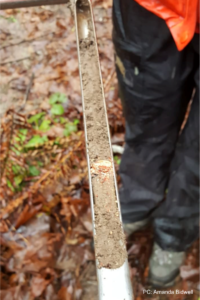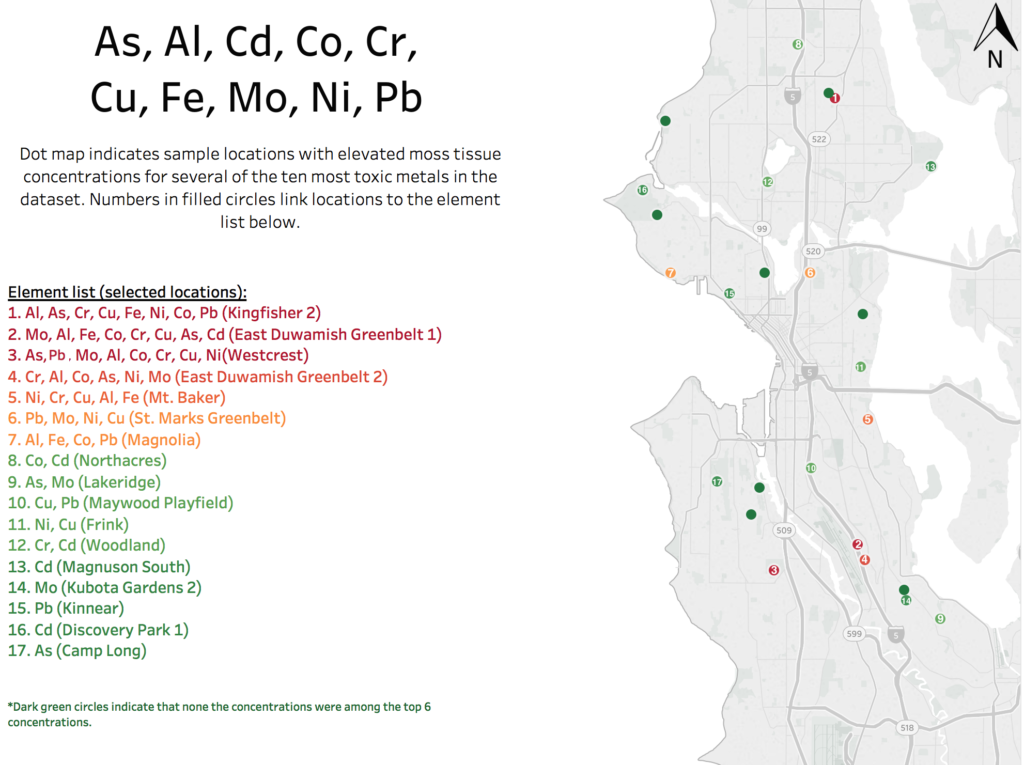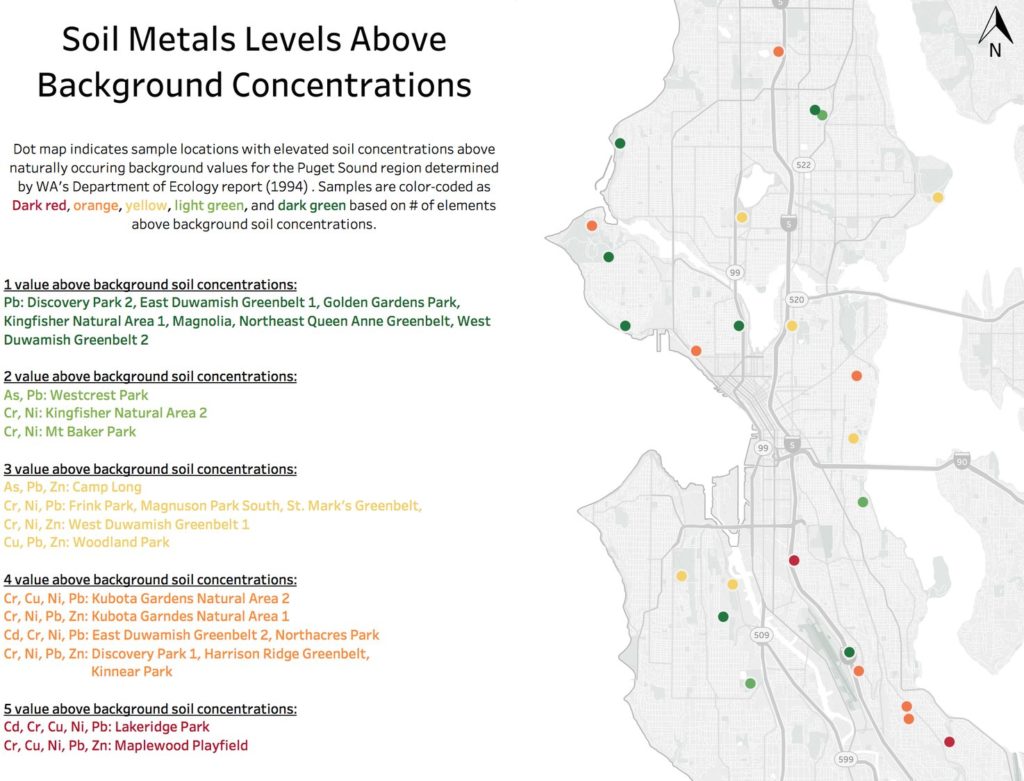 In January 2018, Green Seattle Partnership and Seattle Parks and Recreation partnered with research scientist Amanda Bidwell to conduct a study examining the effects of urban pollution on Seattle’s forests. The objective for this study was to identify ‘hotspots’ of heavy metal pollution in both moss tissue and soil samples collected across 25 priority restoration sites for GSP. The data will inform GSP as to whether metal deposition from increasing traffic and construction is creating a serious threat to forest health throughout Seattle parks and green spaces.
In January 2018, Green Seattle Partnership and Seattle Parks and Recreation partnered with research scientist Amanda Bidwell to conduct a study examining the effects of urban pollution on Seattle’s forests. The objective for this study was to identify ‘hotspots’ of heavy metal pollution in both moss tissue and soil samples collected across 25 priority restoration sites for GSP. The data will inform GSP as to whether metal deposition from increasing traffic and construction is creating a serious threat to forest health throughout Seattle parks and green spaces.
There is a long history of using moss as an inexpensive screening tool to assess areas of heavy metal pollutants from the atmosphere. As moss is non-vascular it absorbs most nutrients from the atmosphere. Moss leaves lack a protective epidermis, which allows for the absorption of water, organic compounds and inorganic ions across their entire surface. Previous studies in the PNW have used a variety of moss species to screen air pollution in Portland, Oregon and western Washington (Gatziolis et al., 2016; Donavan et al., 2016; Bidwell, 2017).
Methods
We measured 20 elements in moss tissue and soil samples collected across Seattle to determine the extent of threat that pollution is posing to urban forest health. At each of the 25 GSP locations, we sampled Orthotrichum lyellii, a moss species that grows abundantly on hardwood trees. Composite soil samples (0-30cm in depth) and bulk density cores were also collected at the same time. All samples were taken back to the University of Washington’s Analytical Service Center and processed for elemental analysis. Both moss and soil samples were analyzed for a suite of 20 metals (Al, As, Ba, Ca, Cd, Co, Cr, Cu, Fe, K, Mg, Mn, Mo, Ni, P, Pb, Si, Sr, Ti, Zn). Measuring metals in the soil samples gives us an understanding of how urban forest soils compare to natural background levels of metals observed in the Puget Sound Region by WA State’s Department of Ecology, which can help guide GSP soil and planting restoration activities.
Results
Based on the moss metal ‘hotspot’ analysis, we created a map of the top 10 most toxic metals in the dataset. The figure below shows locations in the top 6 for the 10 most toxic metals (Al, As, Cd, Co, Cr, Cu, Fe, Mo, Ni, Pb). The top 7 sites identified should be looked at for future study and additional restoration strategies. It is important to note that the metal concentrations observed in the moss samples represent a potential exposure period between several months to 3 years. In order to get an accurate measurement of annual heavy metal wet deposition values, bulk deposition measurements are needed. By using these ‘hotspots’ as a screening tool, organizations that monitor air quality throughout the region can identify areas for future placement of monitoring equipment.
A dot map was also created to show locations where soil concentrations were elevated compared to background values for PSR soils. It is important to note that none of the soil samples in this dataset exceeded the statewide contamination values for As, Cd, Cr, and Pb. The highest levels of soil Pb concentration was observed at Camp Long – Zone 6 Central Forest (73.13ppm) and the highest levels of soil As concentration was observed at Westcrest Park – 4th Ave SW plot (12.67ppm).
Recommendations
Based on the results from this study we have generated a list of recommendations for GSP restoration efforts:
- Tillage and soil mixing in the top 8-12” deep during phase 1 and 2 activities to encourage soil metal dilution in sites that have elevated heavy metal concentrations.
- Mulching and compost additions to replenish soil organic matter, enhance soil biodiversity, and nutrient cycling. Organic matter can help ‘tie up’ heavy metals, thus reducing their bioavailability for potential plant uptake.
- Consider incorporating mycorrhizal inoculates (both endo and ectomycorrhizae species) into bare-root and potted soil mixtures to increase the likelihood of native plant survivorship.
- In areas with elevated levels of soil heavy metals, consider planting native species that are known to tolerate or hyperaccumulate heavy metals. Below is a list of species:
- Slough sedge and Dense sedge: good at treating runoff-based pollutants
- Bracken fern: shown to be effective for uptake and accumulation of Cu and Cr
- Vine maple: shown to be effective for uptake and accumulation of leachates
- Pacific willow: shown to be effective for uptake and accumulation of Cr and Zn
- Scouler’s willow and Yarrow: shown to be effective for uptake and accumulation of Cd
- Douglas fir: shown to be effective for uptake and accumulation of As, Cd, and Pb
In order to continue to advance ecological restoration, GSP utilizes the best available science to help guide best management practices and restoration activities. The results from this study show that stewardship of the urban forest is a process that never ends. Getting a baseline understanding of the chemical status of restoration sites is key to help ensure seedling survivorship and proper soil restoration strategies. By increasing resources in areas where elevated moss and soil metal levels were observed GSP can continue to target their work towards to the goal of creating a health urban forest for all Seattleites.
For more information on this study, check out the GSP report and the complete collection of figures.
Written by guest author Amanda Bidwell




